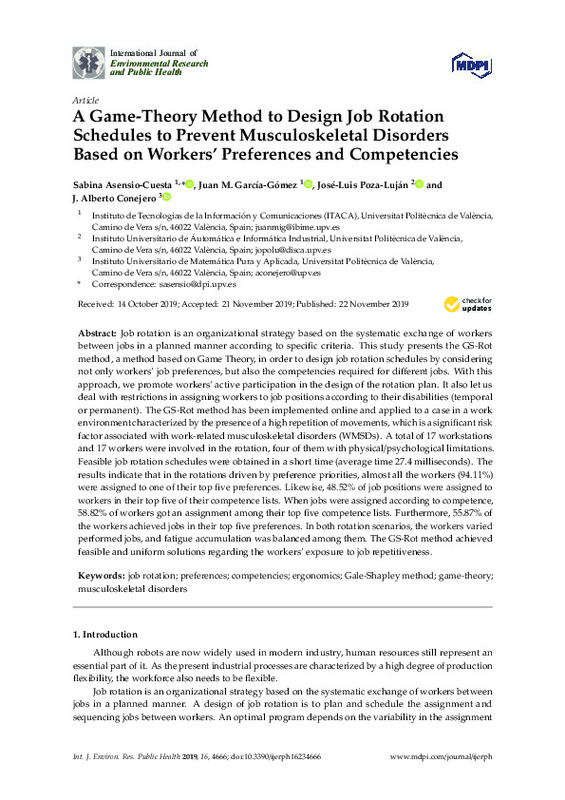Aptel, M., Cail, F., Gerling, A., & Louis, O. (2008). Proposal of parameters to implement a workstation rotation system to protect against MSDs. International Journal of Industrial Ergonomics, 38(11-12), 900-909. doi:10.1016/j.ergon.2008.02.006
Jeon, I. S., Jeong, B. Y., & Jeong, J. H. (2016). Preferred 11 different job rotation types in automotive company and their effects on productivity, quality and musculoskeletal disorders: comparison between subjective and actual scores by workers’ age. Ergonomics, 59(10), 1318-1326. doi:10.1080/00140139.2016.1140816
Botti, L., Mora, C., & Calzavara, M. (2017). Design of job rotation schedules managing the exposure to age-related risk factors. IFAC-PapersOnLine, 50(1), 13993-13997. doi:10.1016/j.ifacol.2017.08.2420
[+]
Aptel, M., Cail, F., Gerling, A., & Louis, O. (2008). Proposal of parameters to implement a workstation rotation system to protect against MSDs. International Journal of Industrial Ergonomics, 38(11-12), 900-909. doi:10.1016/j.ergon.2008.02.006
Jeon, I. S., Jeong, B. Y., & Jeong, J. H. (2016). Preferred 11 different job rotation types in automotive company and their effects on productivity, quality and musculoskeletal disorders: comparison between subjective and actual scores by workers’ age. Ergonomics, 59(10), 1318-1326. doi:10.1080/00140139.2016.1140816
Botti, L., Mora, C., & Calzavara, M. (2017). Design of job rotation schedules managing the exposure to age-related risk factors. IFAC-PapersOnLine, 50(1), 13993-13997. doi:10.1016/j.ifacol.2017.08.2420
Sixth European Working Conditions Survey-6th EWCS-Spainhttps://www.eurofound.europa.eu/surveys/european-working-conditions-surveys/sixth-european-working-conditions-survey-2015/ewcs-2015-methodology
Asensio-Cuesta, S., Diego-Mas, J. A., Canós-Darós, L., & Andrés-Romano, C. (2011). A genetic algorithm for the design of job rotation schedules considering ergonomic and competence criteria. The International Journal of Advanced Manufacturing Technology, 60(9-12), 1161-1174. doi:10.1007/s00170-011-3672-0
Yoon, S.-Y., Ko, J., & Jung, M.-C. (2016). A model for developing job rotation schedules that eliminate sequential high workloads and minimize between-worker variability in cumulative daily workloads: Application to automotive assembly lines. Applied Ergonomics, 55, 8-15. doi:10.1016/j.apergo.2016.01.011
Otto, A., & Scholl, A. (2012). Reducing ergonomic risks by job rotation scheduling. OR Spectrum, 35(3), 711-733. doi:10.1007/s00291-012-0291-6
Carnahan, B. J., Redfern, M. S., & Norman, B. (2000). Designing safe job rotation schedules using optimization and heuristic search. Ergonomics, 43(4), 543-560. doi:10.1080/001401300184404
Song, J., Lee, C., Lee, W., Bahn, S., Jung, C., & Yun, M. H. (2016). Development of a job rotation scheduling algorithm for minimizing accumulated work load per body parts. Work, 53(3), 511-521. doi:10.3233/wor-152232
Boenzi, F., Digiesi, S., Facchini, F., & Mummolo, G. (2016). Ergonomic improvement through job rotations in repetitive manual tasks in case of limited specialization and differentiated ergonomic requirements. IFAC-PapersOnLine, 49(12), 1667-1672. doi:10.1016/j.ifacol.2016.07.820
Sana, S. S., Ospina-Mateus, H., Arrieta, F. G., & Chedid, J. A. (2018). Application of genetic algorithm to job scheduling under ergonomic constraints in manufacturing industry. Journal of Ambient Intelligence and Humanized Computing, 10(5), 2063-2090. doi:10.1007/s12652-018-0814-3
Burgess-Limerick, R. (2018). Participatory ergonomics: Evidence and implementation lessons. Applied Ergonomics, 68, 289-293. doi:10.1016/j.apergo.2017.12.009
Bhuiyan, B. A. (2018). An Overview of Game Theory and Some Applications. Philosophy and Progress, 111-128. doi:10.3329/pp.v59i1-2.36683
Gale, D., & Shapley, L. S. (1962). College Admissions and the Stability of Marriage. The American Mathematical Monthly, 69(1), 9-15. doi:10.1080/00029890.1962.11989827
Roth, A. E. (2008). What Have We Learned from Market Design? The Economic Journal, 118(527), 285-310. doi:10.1111/j.1468-0297.2007.02121.x
Roth, A. E., & Sotomayor, M. (1992). Chapter 16 Two-sided matching. Handbook of Game Theory with Economic Applications, 485-541. doi:10.1016/s1574-0005(05)80019-0
Renna, P. (2017). Decision-making method of reconfigurable manufacturing systems’ reconfiguration by a Gale-Shapley model. Journal of Manufacturing Systems, 45, 149-158. doi:10.1016/j.jmsy.2017.09.005
Butkovič, P., & Lewis, S. (2007). On the job rotation problem. Discrete Optimization, 4(2), 163-174. doi:10.1016/j.disopt.2006.11.003
[-]









